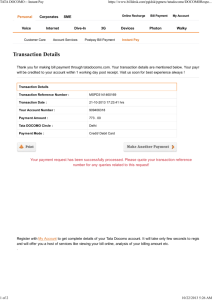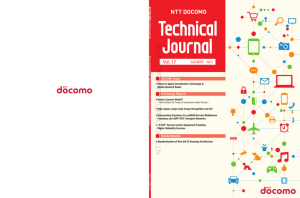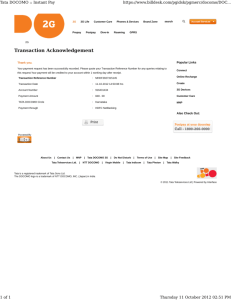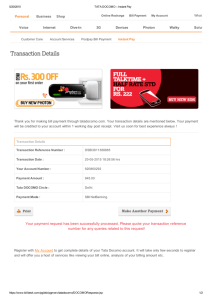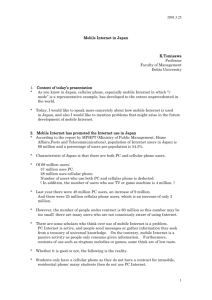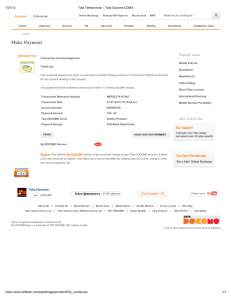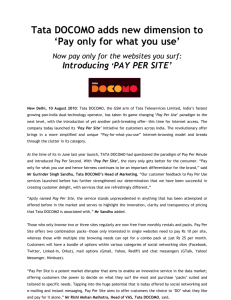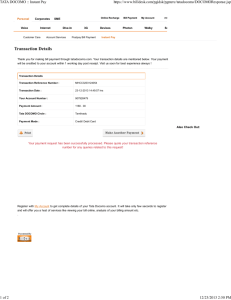Docomo's Quest to Go Global
advertisement
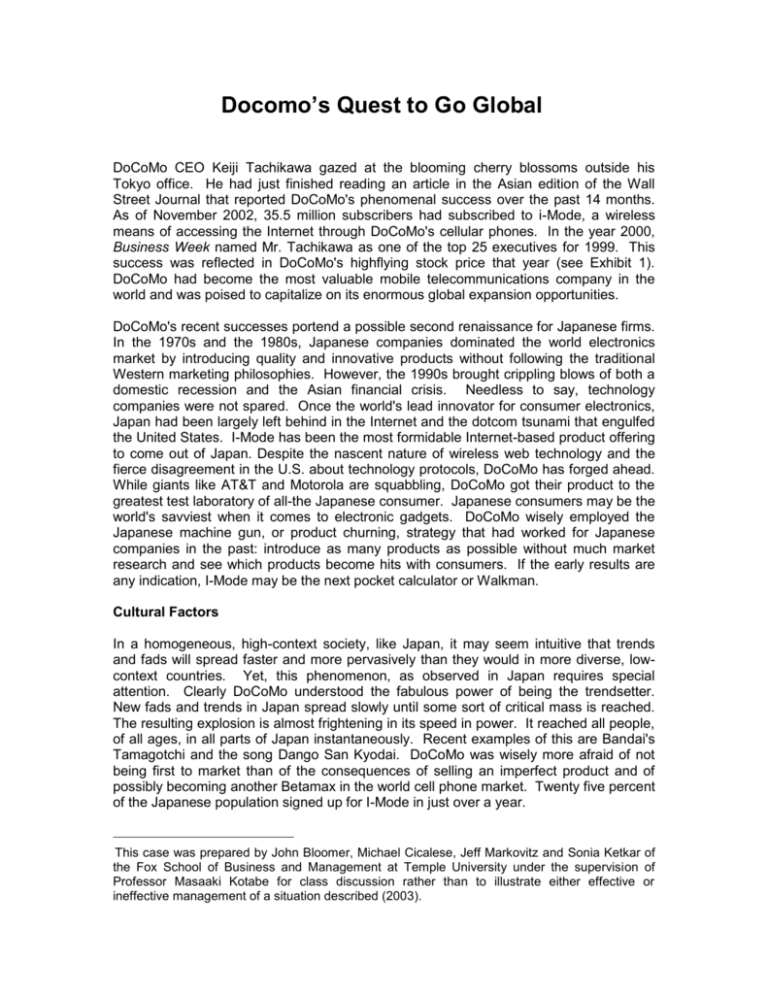
Docomo’s Quest to Go Global DoCoMo CEO Keiji Tachikawa gazed at the blooming cherry blossoms outside his Tokyo office. He had just finished reading an article in the Asian edition of the Wall Street Journal that reported DoCoMo's phenomenal success over the past 14 months. As of November 2002, 35.5 million subscribers had subscribed to i-Mode, a wireless means of accessing the Internet through DoCoMo's cellular phones. In the year 2000, Business Week named Mr. Tachikawa as one of the top 25 executives for 1999. This success was reflected in DoCoMo's highflying stock price that year (see Exhibit 1). DoCoMo had become the most valuable mobile telecommunications company in the world and was poised to capitalize on its enormous global expansion opportunities. DoCoMo's recent successes portend a possible second renaissance for Japanese firms. In the 1970s and the 1980s, Japanese companies dominated the world electronics market by introducing quality and innovative products without following the traditional Western marketing philosophies. However, the 1990s brought crippling blows of both a domestic recession and the Asian financial crisis. Needless to say, technology companies were not spared. Once the world's lead innovator for consumer electronics, Japan had been largely left behind in the Internet and the dotcom tsunami that engulfed the United States. I-Mode has been the most formidable Internet-based product offering to come out of Japan. Despite the nascent nature of wireless web technology and the fierce disagreement in the U.S. about technology protocols, DoCoMo has forged ahead. While giants like AT&T and Motorola are squabbling, DoCoMo got their product to the greatest test laboratory of all-the Japanese consumer. Japanese consumers may be the world's savviest when it comes to electronic gadgets. DoCoMo wisely employed the Japanese machine gun, or product churning, strategy that had worked for Japanese companies in the past: introduce as many products as possible without much market research and see which products become hits with consumers. If the early results are any indication, I-Mode may be the next pocket calculator or Walkman. Cultural Factors In a homogeneous, high-context society, like Japan, it may seem intuitive that trends and fads will spread faster and more pervasively than they would in more diverse, lowcontext countries. Yet, this phenomenon, as observed in Japan requires special attention. Clearly DoCoMo understood the fabulous power of being the trendsetter. New fads and trends in Japan spread slowly until some sort of critical mass is reached. The resulting explosion is almost frightening in its speed in power. It reached all people, of all ages, in all parts of Japan instantaneously. Recent examples of this are Bandai's Tamagotchi and the song Dango San Kyodai. DoCoMo was wisely more afraid of not being first to market than of the consequences of selling an imperfect product and of possibly becoming another Betamax in the world cell phone market. Twenty five percent of the Japanese population signed up for I-Mode in just over a year. This case was prepared by John Bloomer, Michael Cicalese, Jeff Markovitz and Sonia Ketkar of the Fox School of Business and Management at Temple University under the supervision of Professor Masaaki Kotabe for class discussion rather than to illustrate either effective or ineffective management of a situation described (2003). Exhibit 1. DoCoMo’s stock price since July 1999. There is one major cultural factor that made DoCoMo's gamble a solid one: the veritable obsession with staying in touch. A person's social network in Japan is tantamount to life. Social networks consist of family, friends, coworkers and business contacts. Without these important ties, things Americans take for granted like renting an apartment, getting a bank loan or sometimes even getting married are almost impossible to do. The Japanese maintain these intricate social mosaics with an incredible number of both formal and informal prescribed praxes: new year greeting cards, summer and winter gift giving, regular visits and nights out on the town, just to name a few. It is no wonder that cellular phones are as necessary for modern life in Japan as electricity. This effect is magnified among young people who define themselves and are defined by their circle of friends. I-Mode is tailor made for keeping in touch and having fun. These young people constantly e-mail each other and even send pictures to one another on a regular basis with their I-Mode phones. Other factors are related to the premium of space in Japan and the costs associated with phones. People who live in small apartments may be unwilling to dedicate a large percentage of their living area to a computer. If a cell phone can do much of what most people utilize the Internet for, then clearly Japanese people would prefer the cell phone option. Also, many Japanese young people live with their parents until they get married. A cell phone provides the best means for privacy and vital communication for this group. The final issues relate to the cost of landlines and the impact on Internet usage in Japan. To have a landline installed in a home or apartment costs between $900 and $1300. Many young people eschew getting a wired telephone altogether, considering the cost and the fact that a cell phone is a virtual necessity anyway. Another problem is that local calls are not free. Many speculate that this fact along with keyboard-phobia, have kept Internet usage low in Japan. DoCoMo has deliberately focused on ease of usage and has kept the technology hidden. One of DoCoMo's engineers was quoted as saying that they deliberately avoid using words like Internet and World Wide Web because they do not want to alienate potential subscribers. DoCoMo's CEO proudly explained that IMode is so simple that he can get DoCoMo's up to the minute stock price with just two clicks. I-Mode NTT DoCoMo is the wireless unit of Japan's former government-owned phone monopoly. The company's name is a play on the Japanese word for "anywhere." The name is quite appropriate as it applies to DoCoMo's hottest product, the "I-Mode" mobile phone. The I-Mode is a cell-phone that enables its user continuous access to the Internet. It is the only cell-phone in the world that allows its user to have continuous access to the Internet via a cell phone. What sets the I-Mode apart from current American devices, such as the Palm VII by 3Com Corp., is that these systems must establish new dial-up connections each time a user wants to access information from the Internet. The I-Mode stays connected as long as a signal is available and batteries remained charged - a major advantage for any one on the go. The I-Mode is all the rage in Japan among young and old alike. The sleek styles available and the fact that it comes in a lightweight 90-gram design (so light, in fact, that some people carry the I-Mode cell phones on a key chain), give this product mass appeal. Cells phone hardware currently available in Japan far outstrips the US models in form, function and small size. Teenagers love the I-Mode partly because of all of the cool tricks they can perform with it. Using the I-Mode, friends can swap pictures with their friends and quickly send messages back and forth. The benefit to a constant connection is the ability to continuously communicate with other people through written e-mail type messages. Young people stay connected and communicate with friends and relatives until batteries die out. There is also a cartoon service created by Bandai Co. that can be accessed by the I-Mode that has become another very popular feature among young people. People of all ages love the I-Mode because the instant and constant availability to information of all kinds has become an invaluable resource to the student, businessperson, and recreational informational seeker. The I-Mode phones also have the ability to control "smart" appliances in the home and can enable users to activate vending machines with purchases billed to a personal account. DoCoMo History DoCoMo is a spin-off of NTT, the Japanese former telephone monopoly, which holds a 67% stake of DoCoMo. The government ownership has given DoCoMo the advantage of utilizing existing equipment and services providers such as Fujitsu, NEC and Hitachi, as well as a market cap so large that a hostile takeover is virtually impossible. When DoCoMo was spun off from NTT in 1992, few people wanted to be assigned to the project. At that time the market was closed, subscription fees were exorbitant, and the phones were big and bulky. In 1994 the postal ministry liberalized the cell-phone market, giving way to domestic competition that drove the prices of cell-phones down. DoCoMo competed with their competitors, DDI, IDO and TU-KA, by focusing their efforts on developing the world's smallest cell phones, blanketing the country with their retail shops, and promoting product through the use of a mascot named "DoCoMo-Chan." Further, their promotion was well conceived, well targeted and very effective for promoting sales among people of all ages and walks of life. DoCoMo's competition was clearly the impetus for their huge marketing drive. The portable telephone market in Japan was ripe for expansion due to the underlying economics and culture. There are high costs associated with traditional landline phone service in Japan. It is also a fact that many young people live at home until they marry, and portable telephones are an essential means of private, independent, communication among this very mobile demographic. Koji Oboshi, DoCoMo's first president, assigned electrical engineer, Keiichi Enoki, the task of extending the company's business to include data communications. Keiichi Enoki responded by recruiting Takeshi Natsuno, an Internet entrepreneur who at the time was running an online startup. This trio targeted wireless Internet as their focus of operations by designing and building a "packet-switched" network system that enabled many users access to a network at the same time. The Technology I-Mode works off of a business model that is contrary to the current 'free Internet' crusade in America. DoCoMo charges websites a commission for the ability to have users interface with their sites via the I-Mode. The I-Mode is the portal site that contains a menu bar that allows its users to connect to the site. Only web sites that are connected to this licensed first tier, via a fee paid to DoCoMo, can be accessed. I-Mode's dominant features are ease of use and web site compatibility. The I-Mode features a menu bar that easily navigates the web. DoCoMo enhanced its I-Mode product by helping its official content providers customize their I-Mode websites. The customization of websites is important because information needs to be converted so that it is readable on the small I-Mode screen. I-Mode uses a subtext of HTML called compact HTML to convert the information. The user of the I-Mode simply types in the URL to the desired website in order to obtain access. Over 4,000 web sites have already been reconfigured to allow access through the I-Mode due to the ease of conversion for I-Mode accessibility. Prices for the I-Mode cell phone service have been kept cheap in order to guarantee its success. Subscribers pay to send and receive information using the I-Mode. Subscribers pay about 4 cents to send a 250-character message and 2 cents to receive a message of the same size. Customers also pay additional fees to subscribe to other services, such as the cartoon service available from Bandai Co., which charges its subscribers $1 a month. I-mode’s posted revenues of $1.7 billion in 1999, which rose further in the following years to $3.2 billion in 2001. In 2002, however, revenues fell by $6.5 million. The company’s problems exacerbated in early 2002 when it wrote down $7.7 billion of its investment abroad and a further $4.7 billion later that year. DoCoMo is also investing heavily in research. Using I-Mode, connections to the web can be achieved at a speed of 9.6 kilobits per second, which is far slower than a PC with a telephone modem. DoCoMo developed a faster protocol known as 3G (for third generation) that allows a user to connect to the web with a DoCoMo cell phone at 2 megabits per second. The 3G technology was launched in September 2002 and allows users to view streaming video, download high quality music, play virtual reality games, and conduct real-time video conferencing on a cellular device. During the launch, the company aimed to reach a target of 1.38 million users. However, it eventually revised the figure due to the unexpectedly weak response to the new service. Industry experts claimed that the company’s rush to tap first-mover advantages for the 3G service based on untested technology led to the debacle of this product. DoCoMo Today DoCoMo is the world's most valuable cell-phone company and the largest single-country cell-phone operator with a total of 35.5 million subscribers. DoCoMo beat U.S. companies to market with the I-Mode technology with the view that being first into the market was the most important thing. DoCoMo introduced I-Mode cognizant of the fact that they were risking the potential repercussions of rushing to market with a product without being absolutely sure that the product and technology is perfect. Although this strategy is consistent with the Japanese marketing practice of "product churning," DoCoMo is in effect gambling that its technology will be accepted. US companies such as AT&T and Motorola were still examining the technical standards required for the wireless web and trying to determine if the preferred platform would be "smart cell phones" or hand-held (e.g. Palm) computers when I-mode was launched. Later on, in 2002, DoCoMo partnered with AT&T to launch I-mode in the United States. DoCoMo's strategy is that friendly alliances are the only way to be successful in Japan. DoCoMo's current CEO Keiji Tachikawa has argued that the recent hostile takeover strategy pursued by heavyweights such as Vodafone will not play well in the Asian cultures, where long-term relationship building is the way to do business. DoCoMo has done this in the cell-phone market by sharing their technology with both Fujitsu and Matsushita Communications. Utilizing these strategies, DoCoMo hoped to increase their 1999 operating profits of $5 billion on revenues of $36 billion (Revenue projections are shown in Exhibit 2). This goal of increasing profits seemed reachable when looking at the potential for the wireless market in Japan. The wireless market was expected to increase from $18 billion in 1999 to $100 billion in 2003. DoCoMo's strategy of pursuing friendly alliances and non-hostile acquisitions has spilled over Japan's borders. They bought a stake in a Hong Kong wireless company called Hutchison Whampoa, and the plan was to adopt I-Mode and later, 3G in this market. DoCoMo had also reportedly offered $35 billion for a UK-based company called Orange. Orange is a company that was being divested from Germany's Mannesmann following its takeover by Vodafone of Britain (Vodafone is expected to be a future competitor). Finally DoCoMo also entered into strategic alliances with Microsoft and Sun Microsystems in the United States. Revenues ($ billion) 50 40 30 20 10 0 1997 1998 1999 2000 2001 2002 Exhibit 2. DoCoMo’s revenue history with projections and actual sales through 2002. Competition I-Mode can expect to face some serious competition from other recent Internet upstarts in Japan, namely DDI and IDO that have their own Internet service called CdmaOne. CdmaOne currently has over 350,000 subscribers to their e-mail service, but these users must dial in each time they wish to access information. DDI and IDO introduced a packet network WAP (wireless application protocol) to provide a constant connection to the Internet at a higher operating speed. The new packet network will operate at a speed of 14.4 kilobits per second, compared to the I-Mode, which operates at 9.6 kilobits per second. Although the competition holds a slight edge in operating speed over the IMode, DoCoMo is undaunted by this news. DoCoMo is constantly upgrading its technology and believes it will be operating at 2 megabits by 2010. The major problem that the competition must solve in order to be competitive is that WAP cannot be used to access all content on the Internet due to compatibility problems. Every web site, as well as the I-Mode, uses a HTML format to access information. The WAP uses a language called HDML, which is not compatible with most web sites. In order for a user to access information using the HDML language they have to access a web site where operators have reconfigured their content. Although some people believe that the WAP's HDML will replace HTML as the international standard, DoCoMo is not in imminent danger of incompatibility. In fact, DoCoMo is currently in discussions with competitors who make the HDML and HTML work in a compatible format. One of DoCoMo's biggest competitors is Japan Telecom. AT&T, British Telecom and Vodafone have all invested in Japan Telecom. However, AT&T competes with Vodafone in the wireless market in the U.S. and Vodafone also competes with BT around the world. As AT&T, British Telecom, and Vodafone learn from their investment in Japan Telecom, we can probably expect to see them sever ties with Japan Telecom and vie for their own share of the wireless market sometime in the future. Competition with other companies does not exclude collaboration for future technologies. The major players in the wireless Internet market have concluded that the format for wireless service needs to be universal in order to have competition occur on the same playing field. DoCoMo helped launch the Joint Initiative for Mobile Multimedia (JIMM) in order to develop services for 3G, a.k.a. third generation services. JIMM has charged that if competitors do not match protocols, there could be different prevalent services in each country. The operators that have joined this organization are AT&T Wireless, British Telecom, DoCoMo, France Telecom, Singapore Telecom, SK Telecom and Vodafone. DoCoMo hopes to introduce its wideband CDMA service for its newly built network. CDMA, also known as W-CDMA, is a set of high-speed protocols developed by the U.S. military and refined by DoCoMo. This CDMA service is designed for mobile transmission, but will also provide the user with much more than is currently available today. Through the CDMA service DoCoMo hopes to introduce many categories of phones that will handle car navigation, data transmission, music, video (high definition TV quality), as well as voice transmission. In addition to introducing new handset units into the marketplace, DoCoMo will also overhaul the I-Mode to handle CDMA. Although DoCoMo holds many patents on CDMA, it has to compete with many American companies such as Lucent and Qualcomm, which hold similar patents. DoCoMo has helped form the JIMM because it believes that the technology should be reasonable and open to all. In fact, DoCoMo is currently taking part in experiments on CDMA with Ericsson, Lucent, Motorola and Nokia in order to refine the technology. American companies such as Lucent and Qualcomm disagree, maintaining that since they had paid a high cost in research and development, in return they should be paid highly for use of this technology. Since many companies own patents on CDMA technology, they could receive a percentage of all G3 handsets sold. DoCoMo must find a way to sort through all of the patents and come to some kind of an agreement with American companies that have different views on how the technology should be handled. The true factor to competition will come from the type of services offered and the ability for a company to be first to market with a process/technological advance that is ahead of the competition. The areas ripest for technological breakthroughs are easier search methods and cheaper subscription feeds. DoCoMo’s Market Position Current Market Position. There are over 48 million cell-phone users in Japan, more than 70% of whom subscribe to DoCoMo (this includes non-I-Mode users). DoCoMo hoped to continue this market share domination when the 3G standard was adopted in Japan. When the 3G standard was adopted in Japan and in other parts of the world, many DoCoMo critics believed that they would lose market share as handset manufacturers in Europe and America gained access to the 3G technology, enabling them to bring their product to Japan and compete with DoCoMo directly. DoCoMo's position is that as holders of the patents to the chipset, mounting and miniaturization technologies, they will be in a position to produce a smaller, more compact and stylish product than their competitors. They will be able to sell this technology to other companies who wish to sell in areas outside of the DoCoMo global footprint. Companies such as Fujitsu, Matsushita Communication Industrial (Panasonic), Mitsubishi Electric and NEC have been working with this miniaturization technique and could pose a threat to DoCoMo in the future. Right now, the threat is small since collectively they only hold a 20% stake in the global telecom market. Potential Market Position. DoCoMo is counting on forecasts that indicate that by 2010 the Japanese population will exceed 120 million. However, in Japan many people own more than one handset. Therefore Japan's market potential is estimated at 360 million units. Currently, the wireless market in Japan generates more than $50 billion in revenue - 40% of the total telecom revenues. By 2004 market is expected to double to $100 billion with $60 billion coming from mobile Internet business. A group called Mobile Computing Promotion Consortium believes that speech technology will replace the keyboard for creating long text files and would virtually eliminate desktop computing, as we know it. This group predicts that by 2004 there will be 21 million Japanese surfing the web on mobile phones, seven times the current 3 million mobile web users. Expansion Opportunities DoCoMo has plans to expand its wireless services across the globe. DoCoMo believes that in order to be successful, it must ensure entry into all markets. To that end, DoCoMo is willing to offer the necessary support to make sure that its technology is compatible with companies from around the world. Asia is the most viable option for immediate expansion for DoCoMo because of its close proximity and large market segment. Asia has a potential market reach of 3.3 billion, compared to 500 million in Europe and 500 million in the U.S. DoCoMo is currently doing experiments on wideband CDMA in China with Ericsson to move its technology into that country, and its recent stake in Hutchison Whampoa in Hong Kong will also help facilitate further expansion across Asia. DoCoMo is also undergoing similar joint tests in Malaysia and Singapore with further testing plans in the works for South Korea and Thailand. i-Mode in Europe In 2002, DoCoMo partnered with KPN Mobile in Europe to offer its product in Germany, Netherlands and Belgium. In Germany, the i-Mode product is sold by E-Plus, a subsidiary of KPN. DoCoMo and its partner in Europe have retained the same business model as that used in Japan. A large portion of the revenues is shared with the content providers. After its rollout in 2002, the company sold 27,000 handsets in Germany and 7,000 in the Netherlands in the first month or two. Following its launch in these three European markets, DoCoMo has already planned its foray into France and Spain by signing agreements with Bouygues Telecom of France and Spain’s Telefonica (See Exhibit 3). Despite its success in Japan, DoCoMo’s prospects in Europe seemed dull. I-mode has managed to acquire merely 150,000 subscribers in Europe compared with 35.5 million in Japan. i-Mode in America i-Mode made its entry into the United States after DoCoMo purchased a 16% stake in AT&T for $9.8 billion in November 2000. The company had hoped that it would increase its market share in the U.S. telecom market. However, by 2002, the economy slumped, wireless subscriber growth fell by 40% and there was stiff competition from U.S. wireless giants like Verizon, Sprint, Cingular and VoiceStream. To top it, AT&T’s share price dropped and revenues fell. These events had unfavorable repercussions for DoCoMo, which does not even receive licensing fees for lending its technology to AT&T. This also led DoCoMo to reduce its investment in AT&T. Exhibit 3 I-mode’s International Presence Country Germany Partner E-Plus Launch Ownership stake March 2002 Indirect- 15% stake holding in KPN Mobile Netherlands KPN Mobile April 2002 Direct – 15% stake United States AT&T April 2002 Direct - 16% stake Taiwan KG Telecom June 2002 Direct- 21% stake Belgium Base (KPN Orange) Fall 2002 France Bouygues Telecom 2003 Indirect- 15% stake holding in KPN Mobile To be launched Spain Telefonica Moviles 2003 To be launched Note: In October 2002, DoCoMo wrote down its 15% investment in KPN Mobile and some of its investment in AT&T.) Discussion Questions 1. Discuss the role of culture in DoCoMo's strategy and how it will affect the ultimate success of I-Mode. 2. Discuss DoCoMo’s strategy of advocating an open technology standard for the future wireless web. 3. A significant portion of DoCoMo’s revenue model is based on fees received from Internet web sites that pay a commission for access by I-mode users. Will this strategy work in the US, where the “free” Internet is the norm? 4. Will DoCoMo eventually meet similar success in the European and American markets as it did in the Japanese market?

